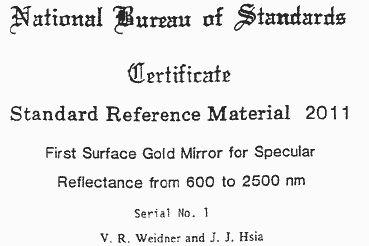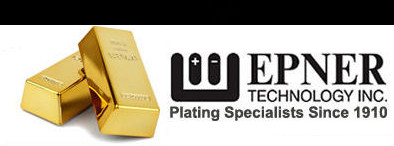 This Standard Reference Material (SRM) is intended for use in calibrating the photometric scale of specular reflectometers. SRM 2011 is a gold mirror 5.1 cm in diameter and 1.2 in thickness. The mirror was produced by electrodepositing gold on an optically polished nickel surface. The nickel was electrodeposited on a hard aluminum substrate. The finished gold mirror flatness is approximately 1 to 2 fringes when tested with the Krypton yellow line at 587.1 nm. The uniformity of reflectance within a central 25 mm diameter area of the mirror is approximately +/-0.001 for the wavelength range 600 to 1200 nm and less than this for longer wavelengths. The mirrors were aged for one year before calibration.
This Standard Reference Material (SRM) is intended for use in calibrating the photometric scale of specular reflectometers. SRM 2011 is a gold mirror 5.1 cm in diameter and 1.2 in thickness. The mirror was produced by electrodepositing gold on an optically polished nickel surface. The nickel was electrodeposited on a hard aluminum substrate. The finished gold mirror flatness is approximately 1 to 2 fringes when tested with the Krypton yellow line at 587.1 nm. The uniformity of reflectance within a central 25 mm diameter area of the mirror is approximately +/-0.001 for the wavelength range 600 to 1200 nm and less than this for longer wavelengths. The mirrors were aged for one year before calibration.
The specular reflectance of each mirror was measured on a high-precision reflectometer for 6° incidence at 50-nm intervals from 600 to 1000 nm 100-nm intervals from 1000 to 1300nm, and 250-nm intervals from 1500 to 2500 nm In addition to these wavelengths, the reflectance was measured at the laser wavelengths of 632.8 and 1060 nm.
The high-precision reflectometer was calibrated with a master mirror which had previously been measured with a highly accurate spectrophotometer with a specular reflectometer attachment. The reflectance of the master mirror was measured at the above wavelengths and at angles of incidence of 6°, 30°, and 45°. These measurements were made for both vertically and horizontally polarized incident beams. The overall uncertainty in these measurements is +/-0.002.
The specular reflectance of the SRM 2011 was measured relative to the master mirror at 6° incidence only. The certified values of specular reflectance for the SRM mirrors are based on the average value of the vertical and horizontal polarizations for the master mirror at 6° incidence. The certified values listed in Table 1 are for the indicated serially numbered mirror only, and have an uncertainty of +/-0.005.
Table 2 lists the reflectance data for the master mirror. These data are not certified, but are provided to show the variation in specular reflectance of a typical first surface mirror as a function of angle of incidence and plane of polarization.
SRM 2011 can be cleaned by bathing in isopropyl alcohol and rinsing with distilled water. Although the gold surface is harder than an evaporated gold surface, it should not be cleaned by rubbing techniques. The mirrors must be handled carefully so as not to touch the gold surface and should be stored in its container when not in use.
This SRM was calibrated in the Radiometric Physics Division of the Center for Radiation Research.
The technical and support aspects involved in the certification and issuance of the SRM were coordinated through the Office of Standard Materials by R. W. Seward.
Stanley D. Rasberry, Chief
Office of Standard Reference Materials
Washington, D.C. 20234
March 19, 1984
